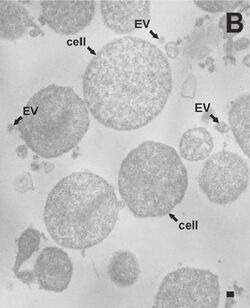Biology:Acholeplasmataceae
| Acholeplasmataceae | |
|---|---|

| |
| Acholeplasma laidwalii cells and extracellular vesicles | |
| Scientific classification | |
| Domain: | Bacteria |
| Phylum: | Mycoplasmatota |
| Class: | Mollicutes |
| Order: | Acholeplasmatales |
| Family: | Acholeplasmataceae Edward & Freundt 1970 |
| Genera | |
| |
| Synonyms | |
| |
Acholeplasmataceae is a family of bacteria. It is the only family in the order Acholeplasmatales, placed in the class Mollicutes. The family comprises the genera Acholeplasma and Phytoplasma. Phytoplasma has the candidatus status, because members still could not be cultured.
Etymology: The names Acholeplasmataceae and Acholetoplasmatales are derived from the Greek a = not, cholè = bile and plasma = anything moulded or formed.[1]
Species in the order Acholeplasmatales can grow in a medium without cholesterol, unlike species in the order Mycoplasmatales. Cholesterol, a sterol, is an important component of the cell membrane of mycoplasmas, whereas in acholeplasmas and in bacteria in general it is absent.
Characteristics
Members of Acholeplasmatales are facultative anaerobic. They are parasites or commensals of vertebrates, insects, or plants; some are saprophytes. [2]
Phytoplasmas colonize the phloem sieve elements of vascular plants, causing diseases. They are transmitted by sap-sucking insects (primarily leafhoppers, planthoppers, and psyllids [3] ), living in the gut, haemolymph, salivary gland and other organs. Like other mollicutes, they show a high host specificity. [4]
Classification
In the first taxonomy of Mollicutes, the classification was based on requiring or not requiring cholesterol for growth. The old order Mycoplasmatales consisted of two families: Mycoplasmataceae, which requires cholesterol, and the sterol-nonrequiring Acholeplasmataceae. [1][5] In view of the many properties in which the acholeplasmas distinguish from species in Mycoplasmataceae and Spiroplasmataceae, Freundt et al. proposed in 1984 to elevate the family Acholeplasmataceae to the ordinal rank Acholeplasmatales, thus separating it from Mycoplasmatales. [6]
In 1987, the division in sterol requiring and not requiring changed with the addition of a third order, Anaeroplasmatales, taking into account that dependence on anaerobic growth conditions is an important characteristic. [7]
The currently accepted taxonomy is based on the List of Prokaryotic names with Standing in Nomenclature (LPSN)[8] and National Center for Biotechnology Information (NCBI)[9]
| 16S rRNA based LTP_08_2023[10][11][12] | 120 marker proteins based GTDB 08-RS214[13][14][15] | |||||||||||||||||||||||||||||||||||||||||||||||||||||||||||||||||||||||||||||||||||||||
|---|---|---|---|---|---|---|---|---|---|---|---|---|---|---|---|---|---|---|---|---|---|---|---|---|---|---|---|---|---|---|---|---|---|---|---|---|---|---|---|---|---|---|---|---|---|---|---|---|---|---|---|---|---|---|---|---|---|---|---|---|---|---|---|---|---|---|---|---|---|---|---|---|---|---|---|---|---|---|---|---|---|---|---|---|---|---|---|---|
|
|
See also
References
- ↑ Jump up to: 1.0 1.1 D.G. Edward, E.A. Freundt Amended nomenclature for strains related to Mycoplasma laidlawii.; J Gen Microbiol. 1970 Jul; 62; PDF
- ↑ Stephens (1983). "Intraspecies Genetic Relatedness among Strains of Acholeplasma laidlawii and of Acholeplasma axanthum by Nucleic Acid Hybridization". Journal of General Microbiology 129 (6): 1929–1934. doi:10.1099/00221287-129-6-1929. PMID 6631407. http://mic.sgmjournals.org/cgi/reprint/129/6/1929.pdf.
- ↑ Weintraub, Phyllis G.; Beanland, Leann (2006). "Insect Vectors of Phytoplasmas". Annual Review of Entomology 51: 91–111. doi:10.1146/annurev.ento.51.110104.151039. PMID 16332205.
- ↑ IRPCM Phytoplasma/Spiroplasma Working Team ‘Candidatus Phytoplasma’, a taxon for the wall-less, non-helical prokaryotes that colonize plant phloem and insects ; Int J Syst Evol Microbiol 54, 1243–1255 (2004).
- ↑ Edward, D. G.; Freundt, E. A. (1969). "Proposal for Classifying Organisms Related to Mycoplasma laidlawii in a Family Sapromycetaceae, Genus Sapromyces, within the Mycoplasmatales". Microbiology 57 (3): 391–395. doi:10.1099/00221287-57-3-391. PMID 5391433.
- ↑ "Proposal for elevation of the family Acholeplasmataceae to ordinal rank: Acholeplasmatales". Int. J. Syst. Bacteriol. 34 (346–349): 346–349. 1984. doi:10.1099/00207713-34-3-346. http://www.microbiologyresearch.org/docserver/fulltext/ijsem/34/3/ijs-34-3-346.pdf?expires=1539538877&id=id&accname=guest&checksum=1ACDF7DE8C211350E7B070FB0664F43D. Retrieved 14 October 2018.
- ↑ "Proposal for an Amended Classification of Anaerobic Mollicutes". Int J Syst Bacteriol 37: 78–81. 1987. doi:10.1099/00207713-37-1-78.
- ↑ J.P. Euzéby. "Acholeplasmatales". List of Prokaryotic names with Standing in Nomenclature (LPSN). https://lpsn.dsmz.de/order/acholeplasmatales.
- ↑ Sayers. "Acholeplasmatales". National Center for Biotechnology Information (NCBI) taxonomy database. https://www.ncbi.nlm.nih.gov/Taxonomy/Browser/wwwtax.cgi?mode=Undef&id=186329&lvl=3&lin=f&keep=1&srchmode=1&unlock.
- ↑ "The LTP". https://imedea.uib-csic.es/mmg/ltp/#LTP.
- ↑ "LTP_all tree in newick format". https://imedea.uib-csic.es/mmg/ltp/wp-content/uploads/ltp/LTP_all_08_2023.ntree.
- ↑ "LTP_08_2023 Release Notes". https://imedea.uib-csic.es/mmg/ltp/wp-content/uploads/ltp/LTP_08_2023_release_notes.pdf.
- ↑ "GTDB release 08-RS214". https://gtdb.ecogenomic.org/about#4%7C.
- ↑ "bac120_r214.sp_label". https://data.gtdb.ecogenomic.org/releases/release214/214.0/auxillary_files/bac120_r214.sp_labels.tree.
- ↑ "Taxon History". https://gtdb.ecogenomic.org/taxon_history/.
Wikidata ☰ {{{from}}} entry
 |

